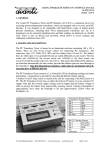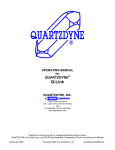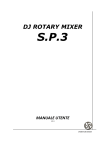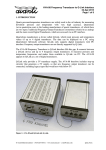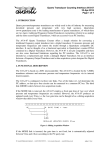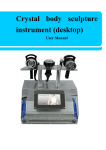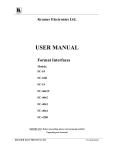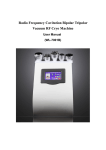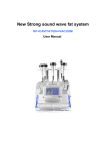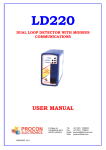Download user manual - Avanti Elektronik Ltd
Transcript
Digital Quartz Transducer Simulator (AVA-02-A) 06-JAN-2015 Page 1 of 6 1. INTRODUCTION The Avanti Digital Quartz Transducer Simulator substitutes a pressure/temperature transducer equipped with a two-wire serial I²C interface. It was designed to be compatible with Quartzdyne's range of digital quartz pressure transducers and facilitates testing of data acquisition systems without the need for real transducers. The simulator also features a special error mode, which simulates erratic I²C behaviour. This is useful for checking how well a data acquisition system recovers from a locked up I²C bus and whether it can detect inconsistent data values. In its latest implementation (model number AVA-02-A) the simulator supports the I²C protocol enhancements introduced by Quartzdyne with ASIC V4.02 (and above). It is backward compatible with earlier versions. 2. HARDWARE DESCRIPTION The simulator consists of a small standalone PCB (circa 50 x 60mm), containing a microcontroller and a serial EEPROM, which are both connected to the I²C bus. There are two rotary switches (labelled PF and TF) for setting pressure and temperature values and a LED, which flashes whenever the simulator has been polled successfully. Two jumper links (labelled A1 and A2) are provided for setting the device address, allowing up to 4 devices on the same I²C bus. The address lines are fitted with pull-up resistors and the jumpers make a connection to ground, i.e. a jumper inserted means the address line is low and a jumper removed means the address line is high. The address lines are also available externally via the 9-way D-type socket, so that alternatively the device address can be coded through ground connections on the host-board. The jumper links must be removed for this. The table below shows the pin-out of the D-type socket. The pin-out is also printed on the bottom side of the PCB. Note that Quartzdyne transducer cables that are terminated with a D-type plug have a different pin-out. Pin-1 Pin-2 Pin-3 Pin-4 Pin-5 Pin-6 Pin-7 Pin-8 Pin-9 A1 SCL GND SDA +VS (2.7V to 5.5V) A2 GND GND GND All external connections are over voltage and reverse voltage protected. However, in order to minimise the possibility of damage through ESD, unnecessary touching of component pins and PCB pads should be avoided. © Avanti Elektronik Limited - (44) 01224 583132 - www.avanti.clara.net - [email protected] dqdsim_15.doc Digital Quartz Transducer Simulator (AVA-02-A) 06-JAN-2015 Page 2 of 6 3. I²C INTERFACE With the introduction of their Digital ASIC in 2009 (V4.02), Quartzdyne made some enhancements to the I²C protocol. These include a checksum as a 5th byte when reading from the transducer, and the extension of the status/control register from a single byte to 4 bytes. These enhancements are backward compatible with earlier versions, i.e. a host system designed for an earlier transducer version will still work with the latest version. Since 2010, the Avanti Transducer Simulator also supports the enhanced I²C protocol of V4.02 and later. Earlier simulators were based on Quartzdyne FPGA V3.02 and may be upgraded on request. Likewise, a new simulator may still be purchased with the older V3.02 firmware, should this be preferred (order as model AVA-02-F). Old and new versions can be distinguished by their serial number. The old version serial number contains digits only (e.g. SN: 0123) while the new version is suffixed with an 'A' for ASIC (e.g. SN: 0123-A) The Avanti Digital Quartz Transducer Simulator supports the following I²C commands. For details refer to the Quartzdyne Digital Transducer Programming Manual. - Query the pressure counter. This returns a 32-bit pressure reading plus a check byte. Reading the check byte is optional. It may be used for validation of the pressure reading. In case a mismatch is found, the pressure value and the check byte can be read again, simply by continuing and reading 5 more bytes. When finished, the read access must be terminated by issuing an I²C STOP. - Query the temperature counter. This returns a 32-bit temperature reading plus an optional check byte as above. - Query the Version-ID. This returns a 32-bit version identifier plus an optional check byte as above. - Query the status register. Up to 4 status bytes plus a check byte may be read as above, but in most applications only the information contained in the first status byte is of relevance (state of the pressure/temperature counters and the EEPROM write protection bit). The other 3 bytes are optional and have no function in the Avanti simulator, but must be included if the check byte is to be verified. - Write to control register. Up to 4 control bytes may be written, but as above, only the first byte is of relevance in most applications. The first byte enables/disables the pressure and temperature counters and locks/unlocks the EEPROM write access. The other 3 bytes may be written, but are simply ignored by the Avanti simulator. - Read/Write the serial EEPROM. The EEPROM is an independent device that shares the same I²C bus. The EEPROM is write protected by default and must be unlocked by writing to the control register, if its contents is to be changed. The EEPROM contains four redundant sets of coefficients at address locations 0...0xFF, 0x100...0x1FF, 0x200...0x2FF and 0x300...0x3FF. © Avanti Elektronik Limited - (44) 01224 583132 - www.avanti.clara.net - [email protected] dqdsim_15.doc Digital Quartz Transducer Simulator (AVA-02-A) 06-JAN-2015 Page 3 of 6 The I²C bus was developed by Philips Semiconductors (now NXP) and its specification can be downloaded from their web-site. In its standard version the I²C bus allows a maximum clock/data frequency of 100kHz, i.e. minimum high and low times of clock and data lines must be observed by the master. The I²C protocol also specifies a mechanism called 'clock stretching', which allows slaves to slow down the bus to below 100kHz. While in the actual Quartzdyne transducer the I²C interface is implemented in an FPGA or ASIC (i.e. entirely in hardware), the Avanti simulator employs a micro-controller with bitlevel I²C support (i.e. a mixture of hardware and firmware). This means that the Avanti simulator is slightly less forgiving with respect to I²C timing issues. In particular 'clock stretching' must be recognised by the master if running at high speed. This happens automatically if the host-micro uses a dedicated I²C port. However, if the I²C interface in the host is 'bit-banged' using two ordinary port pins for SCL and SDA, the host firmware should check explicitly for 'clock stretching'. This is quite simple to implement: It only requires the host firmware to make sure the SCL line actually goes high whenever the SCL pin is set high and, if necessary, to wait for this to happen before proceeding. 4. VALUES RETURNED Pressure and temperature values can be set independently by means of the two rotary switches. For positions 1...8 the returned value is the switch position multiplied by 10kHz, i.e. 10...80kHz. In switch position 0 a ramp is generated, which is repeated every 10 minutes. The pressure ramp starts at 30kHz and ramps upwards at a rate of 1Hz per second. The temperature ramp starts at 40kHz and ramps downwards at a rate of -1Hz per second. In switch position 9 the simulator runs in error mode, which generates regular I²C lockups and checksum errors (see paragraph 5 for details). Switch Position 1 2 3 4 5 6 7 8 9 0 PF 10000 Hz 20000 Hz 30000 Hz 40000 Hz 50000 Hz 60000 Hz 70000 Hz 80000 Hz 30000 Hz with regular I²C errors Ramp 30000...30600 Hz at 1Hz/sec => Sawtooth edge every 10 minutes Raw-Pres returned 0x005B05B1 0x00B60B61 0x01111111 0x016C16C1 0x01C71C72 0x02222222 0x027D27D4 0x02D82D84 0x01111111 Ramp 0x01111111... 0x01168720 TF 10000 Hz 20000 Hz 30000 Hz 40000 Hz 50000 Hz 60000 Hz 70000 Hz 80000 Hz 40000 Hz with regular I²C errors Ramp 40000...39400 Hz at -1Hz/sec => Sawtooth edge every 10 minutes © Avanti Elektronik Limited - (44) 01224 583132 - www.avanti.clara.net - [email protected] Raw-Temp returned 0x005B05B1 0x00B60B61 0x01111111 0x016C16C1 0x01C71C72 0x02222222 0x027D27D4 0x02D82D84 0x016C16C1 Ramp 0x016C16C1.. . 0x0166A0B1 dqdsim_15.doc Digital Quartz Transducer Simulator (AVA-02-A) 06-JAN-2015 Page 4 of 6 The simulator is shipped with coefficients pre-loaded in the EEPROM. These coefficients were taken off a real transducer and therefore produce engineering values, which represent a typical Quartzdyne transducer. Only the serial number and the calibration date were modified to reflect the simulators serial number and date of manufacture. The following table shows the psi and °C values obtained with these coefficients: PF 10kHz 20kHz 30kHz 40kHz 50kHz 60kHz 70kHz 80kHz TF psi -5648.515 psi -252.348 psi 4842.551 psi 9711.851 psi 14431.22 psi 19076.35 psi 23722.88 psi 10kHz -11421.63 236.342 °C 236.342 °C 236.342 °C 236.342 °C 236.342 °C 236.342 °C 236.342 °C 236.342 °C 20kHz 30kHz 40kHz 50kHz 60kHz 70kHz 80kHz -8745.46 psi 194.991 °C -6871.39 psi 150.948 °C -5689.32 psi 98.854 °C -5089.159 psi 33.349 °C -4960.809 psi -50.927 °C -5194.183 psi -159.332 °C -5679.18 psi -297.226 °C -3710.684 psi 194.991 °C -2371.768 psi 150.948 °C -1569.95 psi 98.854 °C -1243.407 psi 33.349 °C -1330.312 psi -50.927 °C -1768.852 psi -159.332 °C -2497.196 psi -297.226 °C 1101.552 psi 194.991 °C 2000.479 psi 150.948 °C 2476.813 psi 98.854 °C 2562.94 psi 33.349 °C 2291.249 psi -50.927 °C 1694.117 psi -159.332 °C 803.938 psi -297.226 °C 5728.189 psi 194.991 °C 6262.484 psi 150.948 °C 6459.496 psi 98.854 °C 6333.302 psi 33.349 °C 5897.976 psi -50.927 °C 5167.578 psi -159.332 °C 4156.19 psi -297.226 °C 10206.17 psi 194.991 °C 10431.37 psi 150.948 °C 10386.63 psi 98.854 °C 10071.10 psi 33.349 °C 9483.968 psi -50.927 °C 8624.385 psi -159.332 °C 7491.532 psi -297.226 °C 14572.43 psi 194.991 °C 14524.28 psi 150.948 °C 14266.73 psi 98.854 °C 13779.75 psi 33.349 °C 13043.32 psi -50.927 °C 12037.38 psi -159.332 °C 10741.93 psi -297.226 °C 18863.92 psi 194.991 °C 18558.34 psi 150.948 °C 18108.34 psi 98.854 °C 17462.68 psi 33.349 °C 16570.13 psi -50.927 °C 15379.43 psi -159.332 °C 13839.35 psi -297.226 °C 23117.58 psi 194.991 °C 22550.67 psi 150.948 °C 21919.97 psi 98.854 °C 21123.30 psi 33.349 °C 20058.50 psi -50.927 °C 18623.38 psi -159.332 °C 16715.77 psi -297.226 °C When queried for the Version-ID, the simulator returns the value 0x0D090403, which reads as Quartzdyne Digital ASIC V4.03. 5. ERROR MODE The Avanti simulator implements two error conditions when in error mode: I²C lockup and checksum error. a) I²C Lockup The Philips/NXP I²C specification doesn't include any timeout mechanism. It is the responsibility of the I²C master to recover from conditions, where the I²C sequence has gone out of synch. This may happen if electrical noise is coupled into the SDA/SCL lines, or if the I²C master is reset while an I²C transfer is in progress, e.g. by a watchdog timer. Also, some of the earlier Quartzdyne transducers didn't always power up in the correct I²C state. This can lead to a situation where the SDA line is stuck low, preventing the master from generating a START or STOP. The I²C bus appears to be locked. The master can overcome this situation by issuing 9 clock pulses while SDA is released. After a maximum of 9 cycles the slave reaches the point where it reads the acknowledgement from SDA. Since SDA is released, the slave reads this as a NACK and terminates. The master should then finish with a STOP. © Avanti Elektronik Limited - (44) 01224 583132 - www.avanti.clara.net - [email protected] dqdsim_15.doc Digital Quartz Transducer Simulator (AVA-02-A) 06-JAN-2015 Page 5 of 6 The operation of such a bus recovery procedure can be checked by setting the simulator into error mode. If the pressure switch is set to position 9, the simulator locks SDA low after every 10th pressure query. Likewise, if the temperature switch is set to position 9, the simulator locks up after every 10th temperature query. The 10th query itself is not affected and returns the correct result. However, the simulator ignores the NACK and the STOP at the end of the transfer and expects the master to clock out further data bits. The simulator is in a state as if it were interrupted during a read access, just after putting data bit-6 onto the bus. The data byte is assumed to be 0x0C (00001100), and therefore SDA is held low. A minimum of 7 clock pulses are required to clock out the remaining data bits and assert a NACK. Additional clock pulses after the NACK have no effect. If both switches (pressure AND temperature) are in position 9, the simulator not only locks up after every 10th pressure and every 10th temperature query, but also powers up in a locked up state. Here the simulator assumes a data byte value of 0x0D (00001101) with SDA stuck at bit-5. While SDA is stuck low, the simulator turns on the LED. If the I²C master in the host controller is implemented properly, it will be able to unlock a stuck I²C bus and no data loss or data corruption should occur. b) Checksum Error If the pressure switch and the temperature switch are both set to position 9, the simulator creates additional data errors every 30sec, which result in an invalid checksum. The data error may occur during a pressure query or a temperature query, whichever is the first after the 30sec error timer has elapsed. In case of a data error, the MSByte of a pressure or temperature query is returned as 0x00 instead of 0x01. This shows up as a pressure frequency of 1875Hz instead of 30000Hz or a temperature frequency of 11875Hz instead of 40000Hz. If the host controller reads and verifies the checksum it will detect a mismatch and read the data bytes again. On the second attempt the data is returned correctly and the checksum is valid. Since earlier versions of digital Quartzdyne transducers (prior to V4.02) do not return a checksum, the host controller should first check the transducer's revision code by reading the identifier, and then take action accordingly. © Avanti Elektronik Limited - (44) 01224 583132 - www.avanti.clara.net - [email protected] dqdsim_15.doc Digital Quartz Transducer Simulator (AVA-02-A) 06-JAN-2015 Page 6 of 6 6. ACKNOWLEDGEMENTS AND FURTHER INFORMATION Quartzdyne is a trademark of Quartzdyne Inc. Information on their range of digital pressure transducers can be downloaded from their web-site at http://www.quartzdyne.com The following documents are of particular interest: DigitalTransSpec.pdf - Digital Quartz Pressure Transducer Specifications DigitalTransProg.pdf - Digital Transducer Programming Manual I²C is a trademark of NXP Semiconductors (formerly Philips). Specifications and application notes can be downloaded from their web-site at http://www.nxp.com The following documents are of particular interest: i2c.bus.specification.pdf - I²C Specification and User Manual Rev.03 / 2007 i2cbits.zip - Software Implemented I2C Drivers ('bit-banged') Avanti Part Number: AVA-02-A Avanti Serial Number: Tested: © Avanti Elektronik Limited - (44) 01224 583132 - www.avanti.clara.net - [email protected] dqdsim_15.doc






